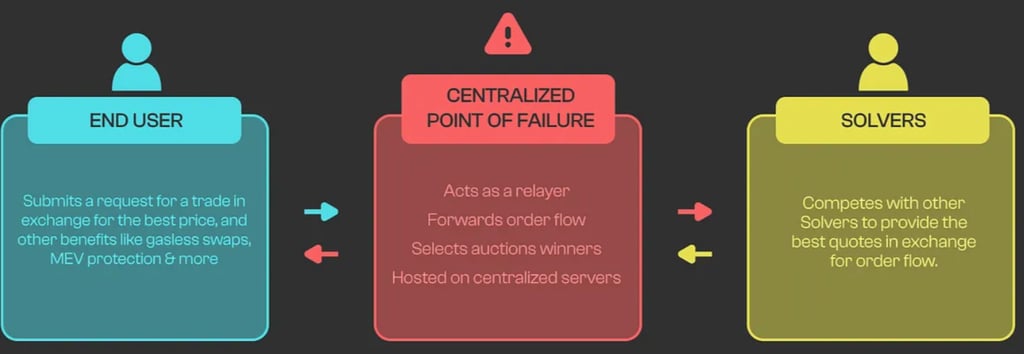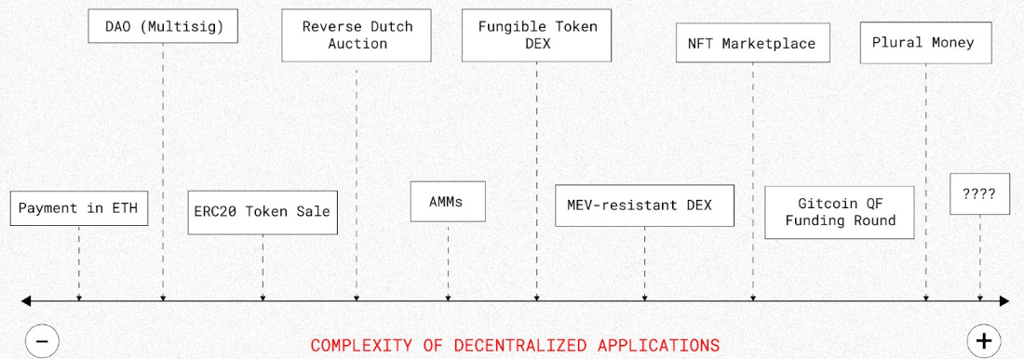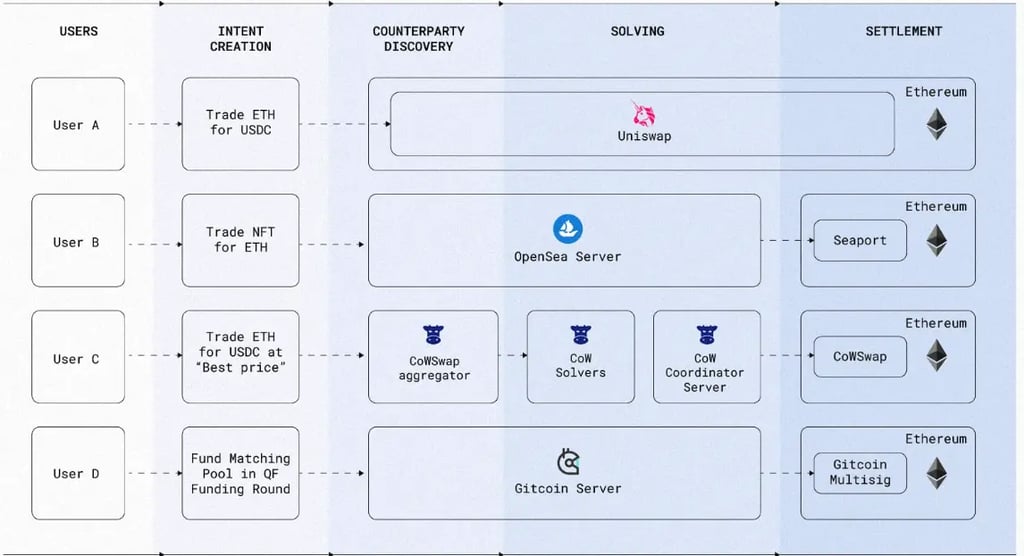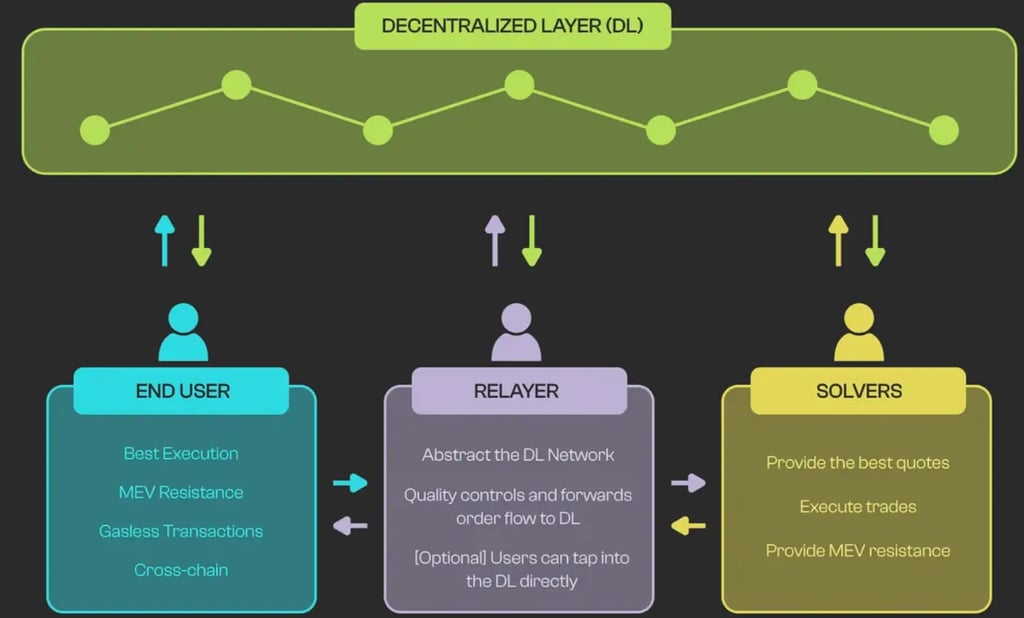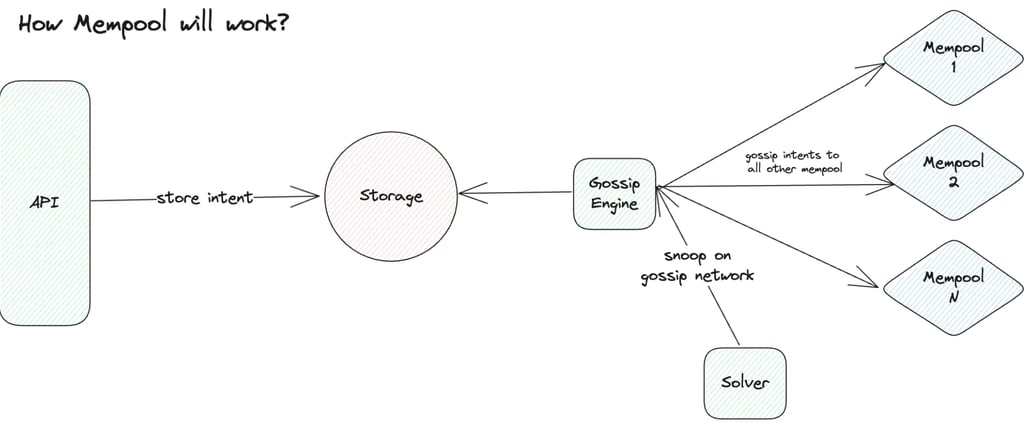Current Blockchain Infrastructure: Not enough for mainstream adoption?
Intent Decentralization: Solving for Blockchain Inefficiency
Rishabh Nagar
8/30/202411 min read
TL;DR
What do you mean by Intent? and Why is it important?
Intents are like digital wishes. They help people achieve what they want to do on the internet, such as sending money or voting, directly and automatically. In the world of crypto, understanding intents is important because they allow people to take control of their actions without needing a middleman or a company. This makes things faster, cheaper, and safer.
Further in this section below:-
Explaining to a 5-year old.
Introduction to Intent Decentralization.
Intents in Decentralized Applications.
Why freedom (chain-agnostic) is important and how intent will help us reach freedom?
Freedom in the crypto world means you can do what you want on any blockchain without worrying about which one you're using, like using the internet without thinking about which Wi-Fi you’re on. Intents are your digital wishes or instructions. To make these wishes come true smoothly across different blockchains, we need freedom (a chain-agnostic approach). This allows your intents to work anywhere, making blockchain technology easier, faster, and more flexible for everyone.
Further in this section below:-
Chain-Agnostic approach to Intents
Need for chain-agnostic framework
Building a chain-agnostic framework
What are the technical components involved in decentralized Intents?
Can you give me some real life examples to better understand Intents?
Ethereum being a pioneer, how is Ethereum trying to solve for Freedom?
Potential future of Intents.
Questions for your thoughts.
Why Are Intents Important in the Crypto World?
Intents are like digital wishes. They help people achieve what they want to do on the internet, such as sending money or voting, directly and automatically. In the world of crypto, understanding intents is important because they allow people to take control of their actions without needing a middleman or a company. This makes things faster, cheaper, and safer.
This section will introduce you to what intent decentralization means and how intents are used in decentralized applications starting with explaining intents to a 5-year-old.
1.1 Explaining to a Five-Year-Old
Imagine you want to send a letter to a friend. Traditionally, you would give it to the mailman (a centralized person) who might take it to a big office first, and then another person would send it to your friend. This is how things are often done in today’s technology world.
Now, imagine if instead, you could just press a button, and your letter would magically appear in your friend's hand. That's what intent decentralization is like—it skips the middleman and does what you want directly, safely, and quickly. It's important because it means you don’t have to worry about anyone else interfering, slowing things down, or losing your letter.
1.2 Introduction to Intent Decentralization
Intents are at the core of what individuals want to achieve—whether it's something simple like transferring assets or more complex, like executing a series of coordinated financial transactions. Traditionally, these intents were managed through centralized systems, but blockchain technology is increasingly allowing them to be fulfilled in decentralized ways.
For example, consider the intent to participate in a decentralized autonomous organization (DAO) vote. In a traditional setup, this would require interaction with a centralized platform, where the vote could be manipulated, delayed, or even censored. In contrast, within a decentralized system, this intent is expressed through a smart contract that automatically collects votes, tallies them, and enacts the decision without needing a central authority.
This shift towards decentralized intent fulfillment is significant because it represents a move away from reliance on centralized intermediaries, empowering users with greater control, transparency, and security over their actions. It allows for the creation of systems where intents can be fulfilled directly, without unnecessary barriers or the risk of third-party interference.
Source: Paraswap
1.3 Intents in Decentralized Applications
In the decentralized world, intents can be simple or complex. A simple intent might be something like executing a trade on a decentralized exchange (DEX), where the user’s desire to swap one cryptocurrency for another is processed directly on-chain, with the transaction being automatically fulfilled once the necessary conditions are met.
However, intents can also be much more complex. Imagine a scenario where a user wants to optimize a portfolio across multiple decentralized finance (DeFi) platforms, balancing yield farming, liquidity provision, and automated trading strategies. This involves not just one action but a series of coordinated interactions with various protocols, each with its unique requirements and risks. Here, the intent is multifaceted and requires sophisticated mechanisms to ensure it’s fulfilled in the most efficient way possible.
In these cases, decentralized mechanisms like smart contracts, oracles, and decentralized or off-chain solvers come into play, enabling the execution of complex intents in a trustless and transparent manner. This represents a significant advancement over traditional systems, where such intricate tasks would be impossible without centralized control.
Source: Anoma
What is a Chain-Agnostic Approach and Why Do We Need Intents for It?
A chain-agnostic approach means that you can do what you want on any blockchain without worrying about which one you’re using. Think of it like using the internet: it doesn’t matter which Wi-Fi you’re connected to—you just want to send a message or watch a video.
In the crypto world, intents are like your digital instructions or wishes. To make them work smoothly across different blockchains, we need a chain-agnostic approach. This way, you can fulfill your intents on any blockchain easily and securely, without needing to understand or care about the differences between them. It's important because it makes using blockchain technology simpler, faster, and more flexible for everyone.
This section will introduce in detail why there is a need for chain-agnostic framework when it comes to building intents.
2.1 Chain-Agnostic Approach to Intents
Intent-Centric Models in Current Ecosystems
Across various blockchain ecosystems, intent-centric models are emerging as a powerful way to simplify user interactions and improve the efficiency of decentralized applications (dApps). For instance, in ecosystems like Ethereum, intents are often processed through smart contracts that handle everything from decentralized finance (DeFi) trades to non-fungible token (NFT) transactions. These systems are designed to ensure that once a user expresses an intent—such as swapping one token for another—the underlying infrastructure takes care of the rest, including finding counterparties, executing the trade, and recording it on the blockchain.
In other ecosystems, such as Polkadot or Cosmos, intent-centric architectures are being explored in ways that leverage these networks' inherent interoperability features. For example, in Polkadot, intents can potentially be fulfilled across different parachains, allowing users to interact with various dApps without worrying about the underlying technical differences between chains. Similarly, Cosmos is experimenting with cross-chain intent fulfillment, where users can initiate actions on one chain and have them completed on another, all while maintaining a high level of security and decentralization.
Source: Anoma
2.2 The Need for a Chain-Agnostic Framework
Despite these advancements, the current ecosystem is still largely fragmented, with most intents tied to specific blockchains. This fragmentation can lead to inefficiencies, as users must navigate different interfaces, standards, and protocols depending on the blockchain they are interacting with. A chain-agnostic framework aims to overcome these challenges by providing a unified system where intents can be expressed, processed, and fulfilled across any blockchain, regardless of its underlying architecture.
In a chain-agnostic model, intents are generalized expressions that are not restricted to any one application or chain. For example, a user might express an intent to trade tokens, and this intent would be handled by the network in the most efficient way possible, regardless of whether the trade occurs on Ethereum, Binance Smart Chain, or another blockchain. This approach not only simplifies the user experience but also enables greater interoperability and composability between dApps across different chains.
Source: Paraswap
2.3 Building a Chain-Agnostic Architecture
To build a truly chain-agnostic intent-centric architecture, several key components are required:
Generalized Intents: Intents must be designed to be flexible and adaptable, capable of being executed on any blockchain without modification.
Decentralized Counterparty Discovery: The system must include a decentralized mechanism for discovering counterparties who can fulfill the intent, regardless of the chain they operate on.
Cross-Chain Solvers: Solvers, which are responsible for executing intents, must be able to operate across multiple blockchains, determining the best route for fulfilling an intent based on factors like speed, cost, and security.
Universal Settlement: Finally, the results of fulfilled intents must be recorded in a way that is recognized across all blockchains, ensuring that users’ actions are validated and secure.
3. What are the technical components involved in Decentralized intents?
With a basic understanding of what intents are and how they function, let's now explore their technical components in the context of intent decentralization.
This section will provide an overview of the underlying mechanisms that make intents work in a decentralized blockchain environment.
Please note that we won't be diving into the formal mathematical definitions here—if you're interested in a more detailed mathematical explanation, I would recommend Lagrangian Mechanics of Intent Solving by Fabrizio Genovese.
Core Components
Generalized Intents: These are the adaptable building blocks that allow users to express outcomes in a decentralized system.
Solver Mechanisms: Decentralized agents interpret and fulfill these intents, working across different blockchains to achieve the user’s goal, whether it’s a simple token swap or a complex financial operation.
Counterparty Discovery: The decentralized process of finding entities to match and fulfill intents is crucial in multi-chain ecosystems, ensuring that the right counterparties are identified without the need for centralized control.
Challenges in Mempool Decentralization
Open vs. Closed Mempools Across Chains: Open mempools allow any solver to access and process intents, promoting transparency but also posing risks like front-running. Closed mempools, on the other hand, offer more security but at the cost of decentralization. The challenge is to balance openness with security, ensuring that intents are processed fairly and efficiently across different blockchains.
Source: Ethresearch
4. Can you suggest some examples of projects trying to work on intent decentralization?
Anoma: Anoma is pioneering a full-stack architecture for decentralized applications that involve infinite users issuing intents of arbitrary complexity. The protocol facilitates intent pooling, where intents are matched and combined to create solutions that satisfy all parties involved. Anoma’s architecture is intent-centric, focusing on enabling novel decentralized applications that are challenging to build on existing blockchain systems.
SUAVE (Single Unifying Auction for Value Expression): SUAVE introduces a decentralized environment for expressing, executing, and settling user preferences. It unbundles the mempool and block builder role from traditional blockchains, allowing for better cross-domain MEV (Miner Extractable Value) management and enabling users to transact with optimal execution. SUAVE operates across multiple blockchains, integrating preferences and intents into a unified auction layer.
Essential: Essential is developing a domain-specific language (DSL) for expressing intents, alongside a modular intent layer that facilitates cross-chain intent execution. Their approach includes creating an Ethereum standard for intent-centric account abstraction, which allows solvers to construct valid transactions based on user intents across existing Ethereum Virtual Machine (EVM) chains.
CoW Protocol: CoW Protocol leverages batch auctions to facilitate decentralized trading by matching orders through a coincidence of wants (CoWs) mechanism. The protocol enables efficient peer-to-peer trading and serves as an aggregator, optimizing liquidity across multiple decentralized exchanges. CoW Protocol is exploring how intent-centric designs can enhance trading efficiency in decentralized finance (DeFi) environments.
ERC-4337 and Ethereum's Approach: ERC-4337 represents Ethereum’s approach to account abstraction, enabling smart contract wallets to process user intents with enhanced flexibility. While primarily designed for single-domain usage, it introduces concepts like UserOps, which are closer to traditional transactions but allow for some intent-like functionality. In contrast to cross-chain solutions, ERC-4337 focuses on improving user experience within the Ethereum ecosystem, with limited applicability to multi-chain environments.
5. How is Ethereum trying to solve for Intents?
This section focuses on a specific case study: ERC-4337, a new standard on the Ethereum blockchain that changes how user accounts and intents are handled. It's designed to provide more flexibility and security for users by enabling smart contract wallets to perform complex operations independently.
If you have a bit more technical understanding of Ethereum, this section will help you explore how ERC-4337 improves intent management within the Ethereum ecosystem. If you're less familiar with the technical details, feel free to skip this section.
Overview of ERC-4337
ERC-4337 introduces a system for account abstraction in Ethereum, designed to make smart contract wallets (SCWs) more independent and capable. This new standard enables users to perform complex operations through their wallets without relying on externally owned accounts (EOAs), addressing a major limitation in the current Ethereum setup.
Key Features
User Operations (UserOps): Instead of traditional transactions, ERC-4337 uses UserOps. These are user-signed operations that detail the desired actions. Multiple UserOps are collected into an alternative mempool and bundled together by specialized entities called bundlers. These bundles are then processed as a single transaction, improving efficiency.
Censorship Resistance: ERC-4337 is built to be as decentralized as possible, mirroring the decentralized nature of Ethereum’s block production. It ensures that no single entity can censor or manipulate UserOps by making the network open to permissionless participation. If all bundlers refuse to process a UserOp, the permissionless nature of the system encourages new bundlers to enter the network and capture potential profits, making the system antifragile.
Security Measures: To protect against misuse and attacks, ERC-4337 enforces several rules:
Gas Usage Limits: Bundlers are protected from denial-of-service attacks by limiting the gas that can be used during the validation phase of a UserOp.
Validation Rules: To prevent operations from being invalidated unfairly, ERC-4337 separates the validation phase from execution, ensuring that a validated operation remains valid as long as the account’s state hasn’t changed.
Reputation System: Bundlers also use a reputation system to manage entities that require relaxed validation rules, ensuring that those entities can’t easily disrupt the network.
Importance of a Unified Mempool
ERC-4337 emphasizes the need for a unified mempool where all bundlers follow the same rules. This uniformity prevents mempool fragmentation, where differing rules could lead to smaller, isolated pools that are more vulnerable to censorship and attacks. A consistent set of rules across all bundlers ensures a stronger, more resilient network, like how Ethereum’s multiple clients adhere to the same protocol rules.
Challenges and Solutions
Fragmentation Risks: If different bundlers applied different rules, the network could fragment, leading to smaller, less secure mempools. ERC-4337 addresses this by establishing a comprehensive test suite and reference implementation, ensuring that all bundlers operate compatibly and safely.
Safe Exceptions: While ERC-4337 sets strict rules, it allows for exceptions in certain cases. Bundlers can participate in alternative mempools with different rules, if they maintain safety and compatibility with the main network. This flexibility allows for innovation while preserving the overall security and integrity of the system.
6. Future of Intent Decentralization
The future of intent decentralization lies in overcoming the challenges posed by current limitations in blockchain infrastructure and the broader ecosystem. As intents shift from traditional transaction-based systems to more declarative, user-centric models, there is significant potential for improved user experience, reduced inefficiencies, and enhanced privacy.
Key Areas of Focus:
Cross-Chain Interoperability: Future developments must enable intents to function seamlessly across multiple blockchains, leveraging the strengths of each while maintaining user control and asset custody.
Decentralized Infrastructure: The design of intentpools—whether permissioned or permissionless—will play a critical role. A decentralized approach that allows open access while ensuring security and trust will be essential for scaling intent-based applications.
Mitigating Centralization Risks: As the adoption of intents grows, especially with standards like ERC-4337, there is a risk of centralization if intent execution becomes dominated by a few entities. The ecosystem must foster competition and innovation to prevent monopolies and ensure fair execution.
Challenges Ahead:
Trust and Transparency: Developers must carefully balance the need for privacy and security with transparency, ensuring that users can trust the systems handling their intents without sacrificing the core principles of decentralization.
Research and Innovation: The field is still nascent, and ongoing research is crucial to address the complexities of intent expression, execution, and integration across different domains. Emerging projects like Anoma, SUAVE, Portikus and others are laying the groundwork, but there is much more to be done.
7. Questions for your thoughts?
How can we make intents work seamlessly across all blockchains without compromising security or speed?
What standards and technologies are needed to ensure intents are easy to use and accessible for everyone, not just tech experts?
How can we prevent centralization and monopolies from forming in the execution of intents across multiple chains?
